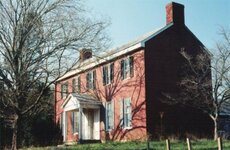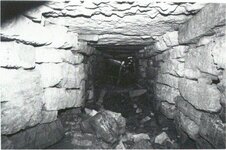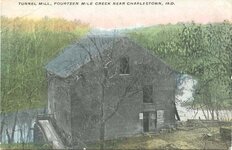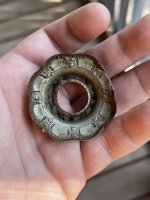Gypsy Heart
Gold Member
By Trisha L. Dunn
[email protected]
Tucked away deep in the corners of a creek’s embankment, not far from Silver Creek High School, a long lost treasure lays sleeping, waiting for some lucky soul to discover.
For long ago when the Indians roamed Clark County, and were trading animal furs with local merchants, a stolen keg of silver coins was buried in the shorelines of Silver Creek.
Off of a winding and steep Tunnel Mill Road, another treasure patiently waits to be found. But, this treasure is of neither silver nor quartz, but of gold. For it was buried deep in the waters of Fourteen Mile Creek when John Work was nearly killed by, and then saved by Indians who had light skin.
Sound too good to be true? Legends of treasure in Southern Indiana creeks may be shrouded in mystery but have buried seeds of truth.
Silver Creek, which flows south to the Ohio River 1-mile east of New Albany is described by Historic Southern Indiana as “Traditionally this name has been associated with a local legend of an Indian silver mine near the stream.”
The Historic Landmarks Foundation of Indiana has published similar legends.
“[Silver Creek] was named so because a band of Indians buried a keg of silver along a creek bank in the area,” according to the foundation’s report on Clark County.
Native Americans and pioneers in the region often clashed. Ongoing trade with the Indians slowed down when the War of 1812 strained their relationships. Constant fear of an Indian raid was on many settlers’ minds.
Jane Sarles, vice president of Clarksville’s Historical Society, said she is very aware of the legend surrounding Silver Creek but hasn’t heard of anyone who’s actually found anything of value.
According to Sarles, the creek was named in the late 1700’s before the town Silver Creek was even born.
“So the legend itself would be old,” Sarles said. Old legends that survive can have some value or truth to themselves.
“Early geologists discovered Copperas on the banks, it could have been mistaken for gold or silver,” she said. Copperas is in the Pyrite family, known as Ferrous Sulfate. Native Americans would carve Pyrite and use it as mirrors. Today, Pyrite is mined for its association with gold and copper.
John Work’s infamous Tunnel Mill rests along Fourteen Mile Creek.
According to author Gary Purlee in “Tunnel Mill,” people would travel from far places, traveling days at a time, just to patronize the mill.
Indians who camped nearby bought flour from Work, giving silver ore in exchange. This made Work wonder where the Indians were producing the silver ore. The Indians told Work that they had a “secret silver mine” nearby that had “unlimited silver,” but that this place would never be revealed to “white men.”
[email protected]
Tucked away deep in the corners of a creek’s embankment, not far from Silver Creek High School, a long lost treasure lays sleeping, waiting for some lucky soul to discover.
For long ago when the Indians roamed Clark County, and were trading animal furs with local merchants, a stolen keg of silver coins was buried in the shorelines of Silver Creek.
Off of a winding and steep Tunnel Mill Road, another treasure patiently waits to be found. But, this treasure is of neither silver nor quartz, but of gold. For it was buried deep in the waters of Fourteen Mile Creek when John Work was nearly killed by, and then saved by Indians who had light skin.
Sound too good to be true? Legends of treasure in Southern Indiana creeks may be shrouded in mystery but have buried seeds of truth.
Silver Creek, which flows south to the Ohio River 1-mile east of New Albany is described by Historic Southern Indiana as “Traditionally this name has been associated with a local legend of an Indian silver mine near the stream.”
The Historic Landmarks Foundation of Indiana has published similar legends.
“[Silver Creek] was named so because a band of Indians buried a keg of silver along a creek bank in the area,” according to the foundation’s report on Clark County.
Native Americans and pioneers in the region often clashed. Ongoing trade with the Indians slowed down when the War of 1812 strained their relationships. Constant fear of an Indian raid was on many settlers’ minds.
Jane Sarles, vice president of Clarksville’s Historical Society, said she is very aware of the legend surrounding Silver Creek but hasn’t heard of anyone who’s actually found anything of value.
According to Sarles, the creek was named in the late 1700’s before the town Silver Creek was even born.
“So the legend itself would be old,” Sarles said. Old legends that survive can have some value or truth to themselves.
“Early geologists discovered Copperas on the banks, it could have been mistaken for gold or silver,” she said. Copperas is in the Pyrite family, known as Ferrous Sulfate. Native Americans would carve Pyrite and use it as mirrors. Today, Pyrite is mined for its association with gold and copper.
John Work’s infamous Tunnel Mill rests along Fourteen Mile Creek.
According to author Gary Purlee in “Tunnel Mill,” people would travel from far places, traveling days at a time, just to patronize the mill.
Indians who camped nearby bought flour from Work, giving silver ore in exchange. This made Work wonder where the Indians were producing the silver ore. The Indians told Work that they had a “secret silver mine” nearby that had “unlimited silver,” but that this place would never be revealed to “white men.”





 ? stvn.
? stvn.


